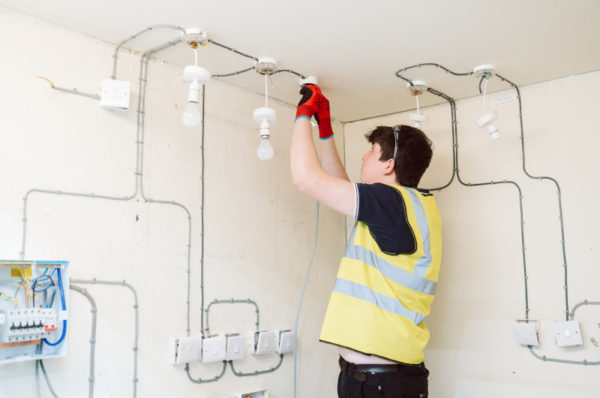The Ultimate Overview to Electrical Installation: Tips and Methods for a Safe and Efficient Home Circuitry System
In the world of home maintenance, couple of aspects are as critical yet typically forgotten as the electric wiring system. Making certain a risk-free and reliable home wiring arrangement demands not just a fundamental understanding of electrical principles but likewise sensible expertise of setup strategies and maintenance procedures. From browsing the details of cord connections to repairing usual issues that may arise, this overview intends to outfit property owners with the crucial tips and tools required for a safe and energy-efficient electric system. By checking out the subtleties of electrical security steps and energy-saving practices, this thorough overview will certainly lose light on the details of home wiring, equipping individuals to take cost of their household's electrical infrastructure.
Comprehending Electric Security Steps
To make certain the security of both people and residential property, understanding and implementing appropriate electrical security procedures is vital in any home circuitry project. It is vital to perform a comprehensive inspection of the electrical system prior to starting any circuitry project to determine possible risks or problems that need to be addressed.
Moreover, making use of the appropriate tools and tools is vital for keeping safety and security throughout electric installations. Shielded handwear covers, voltage testers, and protective eyewear are a few of the fundamental safety equipment that need to be put on to avoid electrical shocks or mishaps. It is likewise vital to de-energize circuits prior to dealing with them and to identify all circuits and breakers clearly to prevent complication.

Essential Tools for Home Wiring
Ensuring the correct application of electrical precaution in home wiring jobs includes utilizing a particular collection of crucial devices developed to facilitate the installation procedure successfully and safely. Several of the secret tools needed for home circuitry jobs include a voltage tester for examining live cords, cable strippers for removing insulation from cables, a wire cutter for specifically cutting cords to size, a screwdriver established for protecting electrical components, electric tape for insulation and securing connections, a wire ripper for removing cable television sheathing, and a multimeter for gauging voltage, current, and resistance. Additionally, a drill with little bits is crucial for producing holes for circuitry and installing electrical boxes, while fish tapes or poles help in pulling cords via conduits or walls. It is vital to purchase top quality devices to guarantee accuracy, efficiency, and security throughout home wiring tasks. By having the needed tools conveniently available, home owners can properly navigate the installation process and keep a secure electrical system within their homes - BRE Electrical Solutions.
Step-by-Step Electrical Setup Guide
Starting an electric installation job requires precise planning and adherence to safety and security standards. Before click here for more starting any type of job, guarantee you have a comprehensive plan laying out the format of the electrical system, including the positioning of electrical outlets, switches, and components. Think about the power demands of each tool to figure out the proper wire scale and circuit breaker sizes.
The very first step in the setup process is to turn off the power supply to the location where you will be working. Make use of a voltage tester to validate that the circuits are de-energized before touching any kind of wires. Next off, very carefully remove existing fixtures or outlets and detach the wires.
When installing new electrical wiring, run wires with wall surfaces and ceilings, safeguarding them in place with suitable installations. Adhere to neighborhood building ordinance and maker directions for correct cable installment and links. BRE Services. Make certain to label cords for easy identification and future maintenance

Troubleshooting Common Circuitry Issues
Having actually completed the installation process as detailed in the previous subtopic, troubleshooting usual electrical wiring issues is a crucial ability for making certain the safety and security and capability of your electrical system. One common issue is a tripped breaker, commonly brought on by overloaded circuits or a brief circuit. To fix this, find visit the website the breaker panel, determine the stumbled breaker by looking for the one not completely in the "on" setting, and reset it by turning it fully to "off" and after that back to "on." Another common issue is a defective electrical outlet, defined by no power or periodic power supply. Make sure the electrical outlet is not controlled by a button, then use a voltage tester to examine for power. If there is no power, transform off the circuit, examine the wiring connections for any kind of loosened or damaged cables, and change the electrical outlet if required. Continually flickering lights can show loosened electrical wiring links or an overloaded circuit. To address this, check and tighten all wire connections in the impacted components and switches and redistribute the load on the circuit to stabilize the electrical demand. On a regular basis checking and without delay resolving these common circuitry issues will keep the safety and security and effectiveness of your home electrical system.
Tips for Energy-Efficient Electrical Equipments
For ideal energy performance in electrical systems, applying smart techniques and making use of energy-saving modern technologies is critical. One vital suggestion for attaining an energy-efficient electrical system is to upgrade to LED lights. Proper insulation and securing of windows, doors, and electric outlets can likewise prevent energy loss, inevitably decreasing the work on electrical systems.
Final Thought
Finally, executing correct safety procedures, making use of vital devices, following a step-by-step installment overview, troubleshooting typical concerns, and incorporating energy-efficient suggestions are vital for a secure and visit the site effective home circuitry system. By sticking to these techniques, homeowners can make sure the durability and performance of their electrical installations. It is very important to prioritize safety and effectiveness when it concerns electric operate in order to prevent potential dangers and to keep a reliable electrical system in the home.